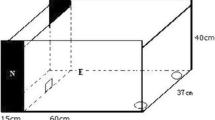Abstract
Rats, subjected to sound-vibration stress, showed an abrupt increase in plasma corticosterone (CS). This stimulation was reliably produced using a Burgess brand “vibro-graver,” a standard tool used for engraving. With the tool set at “8” or coarse, the barrel of the tool was placed on the animal's flank and the point held against the side of the metal cage for 15 s. Plasma CS increased to 29.3±4.7 µg/dl at 15 min and 15.7±1.8 µg/dl at 30 min. These levels were significantly higher than animals pretreated with diazepam, 5 mg/kg IV, 2 h prior to stimulation (9.2±2.0 and 7.4±1.5 µg/dl, respectively). Animals which were pretreated with CGS-8216 (a mixed agonist/antagonist at the benzodiazepine receptor), 2 mg/kg IV, 30 min prior to diazepam had the protective effects of diazepam abolished. Sound/vibration produced a significant elevation in plasma CS in animals given CGS-8216 alone; but, this elevation was significantly lower than in vehicle-treated controls. This comparatively lower plasma CS level suggests a partial-agonist, diazepam-like effect by CGS-8216. Experiments were done in conscious unrestrained male Sprague-Dawley rats with chronic IV catheters. Except for 15 s stimulation exposure, all animals remained isolated in sound-attenuated one-way vision boxes for the duration of the serial blood sampling. Control stimulation exposure involved similar handling without turning on the engraving tool. These results demonstrate: 1) the usefulness of this tool to provide a repeatable stress stimulus; 2) the ability of diazepam to abolish the stress response; 3) that CGS-8216 can antagonize the action of diazepam; and 4) a demonstration of the partial agonist effects of CGS-8216.
Similar content being viewed by others
References
Barlow SM, Knight AF, Sullivan FM (1979) Plasma corticosterone responses to stress following chronic oral administration of diazepam in the rat. J Pharm Pharmacol 31:23–26
Bernard PS, Pastor G, Liebman JM (1986) CGS 8216, a benzodiazepine antagonist, reduces food intake in food-deprived rats. Pharmacol Biochem Behav 24:1703–1706
Bizzi A, Ricci MR, Veneroni E, Amato M, Garattini AS (1984) Benzodiazepine receptor antagonists reverse the effect of diazepam on plasma corticosterone in stressed rats. J Pharm Pharmacol 36:134–135
De Deyn PP, MacDonald RL (1987) CGS 9896 and ZK 91296, but not CGS 8216 and RO 15-1788, are pure benzodiazepine receptor antagonists on mouse neurons in culture. J Pharmacol Exp Ther 2421:48–55
Eisenberg RM (1982) Short-term tolerance to morphine: effects of indomethacin. Life Sci 30:1399–1405
Eisenberg RM (1985) Effects of chronic treatment of diazepam, phenobarbital, or amphetamine on naloxone-precipitated morphine withdrawal. Drug Alcohol Depend 15:375–381
Eisenberg RM (1987) Diazepam withdrawal as demonstrated by changes in plasma corticosterone A role for the hippocampus. Life Sci 40:817–825
Eisenberg RM, Johnson C (1989) Effects ofβ-carboline-ethyl ester on plasma corticosterone — a parallel with antagonist-precipitated diazepam withdrawal. Life Sci 44:1457–1466
Fekete MIK, Szentendrei T, Kanyicska B, Palkovits M (1981) Effects of anxiolytic drugs on the catecholamine and dopac (3,4-dihydroxyphenylacetic acid) levels in brain cortical areas and on corticosterone and prolactin secretion. Psychoneuroendocrinology 6:113–120
Glick D, Von Redlich D, Levine S (1964) Fluorometric determination of corticosterone and cortisol in 0.02–0.05 milliliters of plasma or submilligram samples of adrenal tissue. Endocrinology 74:653–655
Keim KL, Sigg, EB (1977) Plasma corticosterone and brain catecholamines in stress: effect of psychotropic drugs. Pharmacol Biochem Behav 6:79–85
Knych ET, Eisenberg RM (1979) Effect of amphetamine on plasma corticosterone in the conscious rat. Neuroendocrinology 29:110–118
Kumar BA, Forster MJ, Lal H (1988) CGS 8216, a benzodiazepine receptor antagonist, enhances learning and memory in mice. Brain Res 460:195–198
Lahti RA, Barsuhn C (1974) The effect of minor tranquilizers on stress-induced increases in rat plasma corticosteroids. Psychopharmacologia 35:215–220
Lahti RA, Barsuhn C (1975) The effect of various doses of minor tranquilizers on plasma corticosteroids in stressed rats. Res Commun Chem Pathol Pharmacol 11:595–603
Lamb RJ, Griffiths RR (1987) Effects of Ro 15-1788 and CGS 8216 in diazepam-dependent baboons. Eur J Pharmacol 143:205–212
McNicholas LF, Martin WR (1986) Benzodiazepine antagonist, CGS-8216, in diazepam- or pentobarbital-dependent and non-dependent rats. Drug Alcohol Depend 17:339–348
Petraglia F, Bakalakis S, Facchinetti F, Volpe A, Muller EE, Genazzani AR (1986) Effects of sodium valproate and diazepam on beta-endorphin, beta-lipotropin and cortisol secretion induced by hypoglycemia stress in humans. Neuroendocrinology 44:320–325
Sanger DJ (1986) Investigation of the actions of the benzodiazepine antagonists Ro 15-1788 and CGS 8216 using the schedule-controlled behavior of rats. Pharmacol Biochem Behav 25:537–541
Zharkovskii AM, Zharkovskaia TA (1987) Characteristics of the abstinence syndrome induced by the administration of the benzodiazepine antagonist CGS 8216 to rats following chronic treatment with diazepam. Biull Eksp Biol Med 104:318–21
Author information
Authors and Affiliations
Rights and permissions
About this article
Cite this article
Eisenberg, R.M. Sound vibration, a non-invasive stress: antagonism by diazepam. Psychopharmacology 110, 467–470 (1993). https://doi.org/10.1007/BF02244654
Received:
Revised:
Issue Date:
DOI: https://doi.org/10.1007/BF02244654




